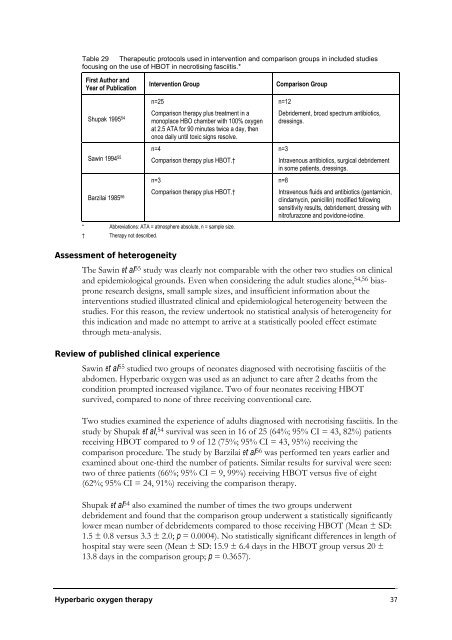Hyperbaric Oxygen Therapy - Hyperbaric Chamber Information ...
Hyperbaric Oxygen Therapy - Hyperbaric Chamber Information ...
Hyperbaric Oxygen Therapy - Hyperbaric Chamber Information ...
Create successful ePaper yourself
Turn your PDF publications into a flip-book with our unique Google optimized e-Paper software.
Table 29 Therapeutic protocols used in intervention and comparison groups in included studies<br />
focusing on the use of HBOT in necrotising fasciitis.*<br />
First Author and<br />
Year of Publication<br />
Shupak 1995 54<br />
Sawin 1994 55<br />
Barzilai 1985 56<br />
Intervention Group Comparison Group<br />
n=25<br />
Comparison therapy plus treatment in a<br />
monoplace HBO chamber with 100% oxygen<br />
at 2.5 ATA for 90 minutes twice a day, then<br />
once daily until toxic signs resolve.<br />
n=4<br />
Comparison therapy plus HBOT.†<br />
n=3<br />
Comparison therapy plus HBOT.†<br />
* Abbreviations: ATA = atmosphere absolute, n = sample size.<br />
† <strong>Therapy</strong> not described.<br />
n=12<br />
Debridement, broad spectrum antibiotics,<br />
dressings.<br />
n=3<br />
Intravenous antibiotics, surgical debridement<br />
in some patients, dressings.<br />
n=8<br />
Intravenous fluids and antibiotics (gentamicin,<br />
clindamycin, penicillin) modified following<br />
sensitivity results, debridement, dressing with<br />
nitrofurazone and povidone-iodine.<br />
Assessment of heterogeneity<br />
The Sawin et al55 study was clearly not comparable with the other two studies on clinical<br />
and epidemiological grounds. Even when considering the adult studies alone, 54,56 biasprone<br />
research designs, small sample sizes, and insufficient information about the<br />
interventions studied illustrated clinical and epidemiological heterogeneity between the<br />
studies. For this reason, the review undertook no statistical analysis of heterogeneity for<br />
this indication and made no attempt to arrive at a statistically pooled effect estimate<br />
through meta-analysis.<br />
Review of published clinical experience<br />
Sawin et al55 studied two groups of neonates diagnosed with necrotising fasciitis of the<br />
abdomen. <strong>Hyperbaric</strong> oxygen was used as an adjunct to care after 2 deaths from the<br />
condition prompted increased vigilance. Two of four neonates receiving HBOT<br />
survived, compared to none of three receiving conventional care.<br />
Two studies examined the experience of adults diagnosed with necrotising fasciitis. In the<br />
study by Shupak et al, 54 survival was seen in 16 of 25 (64%; 95% CI = 43, 82%) patients<br />
receiving HBOT compared to 9 of 12 (75%; 95% CI = 43, 95%) receiving the<br />
comparison procedure. The study by Barzilai et al 56 was performed ten years earlier and<br />
examined about one-third the number of patients. Similar results for survival were seen:<br />
two of three patients (66%; 95% CI = 9, 99%) receiving HBOT versus five of eight<br />
(62%; 95% CI = 24, 91%) receiving the comparison therapy.<br />
Shupak et al 54 also examined the number of times the two groups underwent<br />
debridement and found that the comparison group underwent a statistically significantly<br />
lower mean number of debridements compared to those receiving HBOT (Mean ± SD:<br />
1.5 ± 0.8 versus 3.3 ± 2.0; p = 0.0004). No statistically significant differences in length of<br />
hospital stay were seen (Mean ± SD: 15.9 ± 6.4 days in the HBOT group versus 20 ±<br />
13.8 days in the comparison group; p = 0.3657).<br />
<strong>Hyperbaric</strong> oxygen therapy 37



